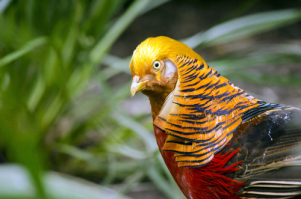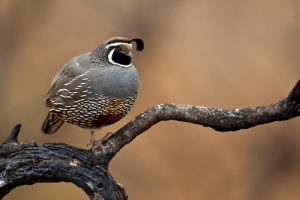By: David Torres
Game birds are typically considered to belong in the galliform order of birds. They are called game birds because they are frequently hunted for meat and for sport. Galliformes consist of some of the most well-known birds such as peacocks, pheasants, turkeys, and chickens. Galliforms are mostly flightless or short distance birds that are usually more comfortable on the ground than in the air. Some game birds such as chickens and turkeys have been farmed for centuries for meat, eggs, and also to be kept as pets.

What do they look like?
Galliformes vary greatly in size from 12-120 cm. Most are plump-bodied with thick necks and moderately long legs, and have rounded and rather short wings. Many adult males have one to several sharp horny spurs on the back of each leg, which they use for fighting. They do not fly well if at all, but walk and run instead for transportation. Galliformes species have strong legs with four digits that are designed for their terrestrial life.
What do they eat?
Game birds feed on a variety of plants, flowers, leaves, seeds, and roots. Some Have been known to also eat small animals, which may include insects, snails, worms, lizards, snakes, rodents, and eggs.
They have been known to eat almost anything they can for survival, but mostly stick to plants and insects they find on the ground. These birds sometimes have to dig for their food so there clawed feet are stronger than the birds that are always flying or perched on a thin branch.

Where do they live?
These kinds of birds can be found all over the world. They live on every continent except Antarctica. Some of these birds were introduced to other countries by way of human migration.
Birds belonging to the galliformes order can be found in a variety of habitats, including forests, deserts, and meadows.
What types are there?
We’ll go over the five families of birds in the galliformes order that are commonly called game birds. There are several different species in each galliform family, but all of them share similar features and living habits that help classify them in this order.
They all have plump, larger upper body with relatively smaller wings and can usually be found pecking at the ground for food. They typically stay close to the ground and are not known to be long-distance migratory birds.

Phasianidae
These birds are often referred to by a generic term of Pheasants. The phasianidae family includes Old World quails, peacocks, turkeys, and partridges. Pheasants are large, colorful and long-tailed birds that can vary greatly in color. Male pheasants are larger than females on average, and they sometimes have spurs.
This family is one that can be found all over the world thanks to natural selection or human intervention. This diverse set of birds are also considered to be the largest in number compared to some of the other bird families on this list.

Odontophoridae
This family of birds is one of the smaller groups and is often referred to as new world quails. As the name suggests these birds are found all around the americas. They are generally short-winged, necked and tail compared to their quail relatives on the other continents. Their legs are short and powerful and lack the spurs of many Old World galliforms.
New world quails are capable of short bursts of strong flight, but they prefer to stay on the ground to walk and will run from danger, taking off in flight only as a last resort. Their coloration varies with males having brighter plumage and many species have ornamental crests on the head.
Numididae
There are only six species in this family of birds. They live in Sub-Saharan Africa and grow to be 17-24 inches in length. Birds belonging to the numidiae family have a bare head and neck, a short, rounded tail; a short, curved bill; and a pear-shaped body. They have grayish-black feathers spotted with white.
These birds can fly, but they are very fast runners and usually run to escape danger. They roost in trees at night and make their nests on the ground. This family of birds are also known as guinea hens or guineafowl and have been domesticated in some places to be raised for food.
Cracidae
The Cracidae family of birds comprises of about 50 species. They’re commonly referred to as curassows, guans, or chachalacas. Cracids are large, blunt-winged birds with long, broad tails. Many species have ornaments or crests on the head or bill. They are mostly forest-dwelling birds and can be found in southern North America through much of South America.
Cracids are medium to large chicken-like birds with blunt-wings and long, broad tails. These birds generally have dark plumage that is brown, black, or gray in color. In many cracids, males are larger than females. Curassows are crested with curved feathers on top of the head. Some cracids have brightly colored skin on the face or neck, or ornaments such as wattles, casques or combs. The coloration of these parts may vary with breeding and may play a role in mate choice.
Megapodiidae
Megapodes are found in forests in Australia, New Guinea, and surrounding islands through to Indonesia and the Philippines. There are over 20 species in this particular family. They are large turkey-like birds, that are 20-27 inches in length.
Megapodes are also known as mound builders because of their unique nest building and incubation method. They create a nest mound of dried vegetation and sand and bury their eggs in the mound. Some members of this family place their eggs in burrows or pits in the ground and let the sun’s warmth incubate the eggs.
